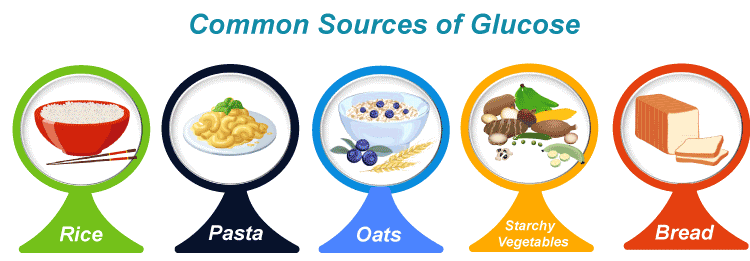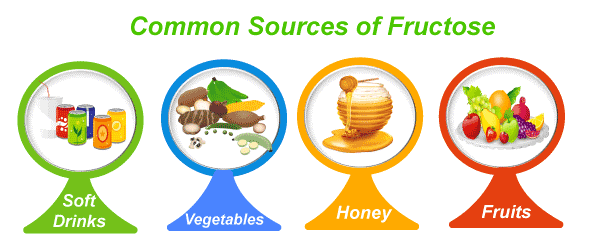Glucose vs Fructose
Difference between Glucose and Fructose
‘Fructose’ and ‘glucose’ are both monosaccharide sugars with a simple structure. When starch and sugar, whether sucrose or high-fructose corn syrup (HFCS), are digested, they produce a lot of glucose. Despite the fact that fructose and glucose have the same calorific value, they are metabolized differently in the body. Although fructose has a lower glycemic index than glucose, it has a much higher glycemic load. Fructose produces seven times the cell damage as glucose because it binds to cellular proteins seven times faster and releases 100 times the amount of oxygen radicals (such as hydrogen peroxide, which kills everything in sight).
Fructose is a basic sugar that may be found in a wide variety of fruits and vegetables. In addition, large volumes are produced in the lab. All main carbs, including as starch and table sugar, contain glucose, commonly known as grape or blood sugar. While both are vital sources of energy, too much glucose can be lethal for diabetics, while too much fructose can lead to insulin conflict and liver impairment.
Glucose
Glucose, often known as grape sugar, is a monosaccharide. It's an aldo-hexose sugar. Our muscles and brain favour glucose as a source of energy. It's a ring with six members. It takes the shape of a pyranose ring. It's called aldohexose. It is the body's primary and preferred energy source. Glucose is found in starch.
From sucrose (cane sugar): Boiling sucrose in an alcoholic solution with dilute HCl and H2SO4 yields glucose and fructose in exactly equal quantities.

From Starch: Glucose may be made from starch by hydrolyzing it in boiling and dilute H2SO4 at temperature of 393 K under pressure.

Uses of Glucose
- It is given to patients who are severely sick and unable to feed because it contains carbs, which supply calories.
- It is utilised as a precursor in the synthesis of matter.
Sources
Rice, oats, bread, pasta, and starchy vegetables are common sources.

Calories
One ounce of glucose has 110 calories in it.
Fructose
Fructose is a naturally occurring sugar that is largely processed in our liver. Fructose is utilized to create energy via glycolysis. Unlike glucose, fructose is involved in lipogenesis, the process through which fat is produced. When fructose reacts with other monosaccharides, oligosaccharides are produced. When compared to glucose, fructose has a subordinate ‘glycemic index’. Fructose binds to cellular protein seven times faster than glucose does. Fruit sugar, or D- fructose, is another name for fructose. The ketone is its functional group. It is mostly processed in the liver. It is absent from starch.
Uses of Fructose
- In the food business, crystalline fructose is used to enhance flavour.
- It can be found in flavoured water, energy drinks, low-calorie foods, and so on.
- Fruit sugar is used to make suave, damp cookies, nutrition-bars, low-calorie goods, and so on.
Sources
Fruit’s, honey, soft drinks, and vegetable’s (in small quantities) are common sources.

Calories
Fructose has 104 calories per ounce.

| GLUCOSE | FRUCTOSE | |
| Also known as | Corn-sugar, Blood-sugar, ‘Dextrose’, grape sugar | Laevulose, Fruit sugar, D-fructose |
| Sugar-type | ‘Monosaccharide’ (Simple -sugar) | ‘Monosaccharide’ (Simple -sugar) |
| Molecular formula | C6H12O6 | C6H12O6 |
| Functional group | ‘Aldehyde’ | ‘Ketone’ |
| Usages | An energy source. Provides energy for cellular respiration. | An energy source. To enhance the flavour of food and beverages, it is frequently added. |
| Made by | The breakdown of glycogen during photosynthesis. | The breakdown of glycogen during photosynthesis. The food business produces massive amounts of food in a lab. |
| Molar mass | 180.16 g/mol | 180.16 g/mol |
| Density | 1.54 g/cm3 | 1.694 g/cm3 |
Effects on the Body
A dangerously high blood glucose level might be fatal. However, diabetics only experience this when their pancreas fails to release enough insulin into the circulation. The majority of fat gained by high glucose consumption is subcutaneous fat, which is not linked to heart disease or diabetes. Insulin confrontation and raised up cholesterol are not connected to glucose. According to studies, consuming glucose dramatically increases brain activity.
Insulin confrontation, corpulence, and non-alcoholic liver illness have all been related to excessive fructose consumption. According to studies, it causes belly fat to accumulate, which is related to an increased risk of heart disease and diabetes. Fructose also raises cholesterol levels. According to studies, fructose reduces activity in the brain's cortical control regions.
Lane MD of Johns Hopkins University School of Medicine in Baltimore has published a research that found:
- Food intake is increased by fructose, but food intake is decreased by glucose. This is due to the fact that glucose increases hypothalamic ATP, which suppresses food intake. Fructose, on the other hand, necessitates the usage of an enzyme that demands ATP, resulting in ATP depletion and, as a result, an increase in food consumption. High-fructose sweeteners, soft drinks, and corn syrup use have all increased in tandem with the obesity pandemic.
- High fructose diet enhances hepatic lipogenesis through promoting insulin confrontation and glucose intolerance.
Beneficial uses in the human body
Glucose is also used by cells to power respiration. It's also utilized to make Vitamin A and to make a variety of other compounds including starch and glycogen. Fructose is utilized in the production of ATP and the formation of glycogen during respiration. It can also make fat in order to conserve energy.